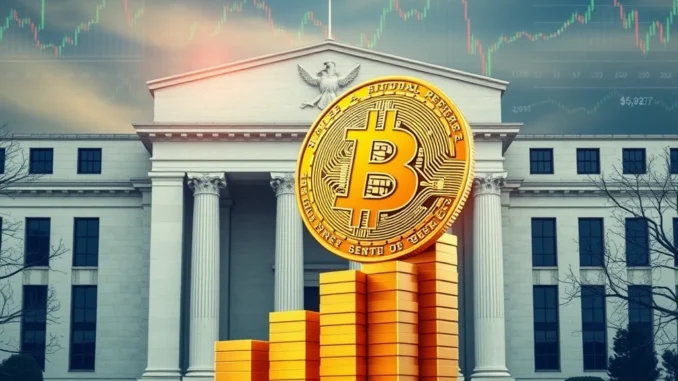
Bitcoin’s recent price movements have sparked a flurry of discussions across the crypto community. As the digital asset navigates market volatility, experts are keenly observing the factors that could dictate its next major move. Standard Chartered’s Geoff Kendrick offers a compelling perspective, suggesting that Bitcoin’s future trajectory is closely intertwined with shifts in Fed policy. Let’s dive into this analysis and explore what it means for the world’s leading cryptocurrency.
Decoding Standard Chartered’s Bitcoin Price Prediction: A $200,000 Target on the Horizon?
Despite recent dips, Standard Chartered remains remarkably optimistic about Bitcoin’s long-term prospects. Geoff Kendrick, a key analyst at the financial institution, attributes the current downturn not to any fundamental flaws within the crypto space itself, but rather to broader risk asset weakness affecting global markets. This is a crucial distinction, suggesting that the factors influencing Bitcoin’s price are macroeconomic rather than crypto-specific.
But what fuels this optimism, particularly in the face of market uncertainty? Kendrick points to a bold year-end Bitcoin price prediction of $200,000. This ambitious target isn’t based on wishful thinking; it’s rooted in potential catalysts that could reshape the economic landscape and, by extension, the crypto market. These catalysts primarily revolve around:
- Federal Reserve Rate Cuts: The anticipation of a shift in Fed policy, specifically a move towards lowering interest rates, is a major driver. Lower interest rates generally make risk assets like Bitcoin more attractive to investors.
- Sovereign Bitcoin Adoption: The possibility of nations officially adopting Bitcoin as part of their financial reserves or even as legal tender could inject significant demand and legitimacy into the market.
Kendrick’s analysis provides a framework for understanding Bitcoin’s current position and potential future growth, linking it directly to broader economic trends and policy decisions.
The Pivotal Role of Fed Policy: How Interest Rate Decisions Could Trigger Bitcoin’s Recovery
The central theme of Standard Chartered’s analysis is the profound impact of Fed policy, particularly interest rates, on Bitcoin’s value. To understand this connection, it’s essential to grasp the basic mechanics of how interest rates influence investment decisions.
When interest rates are high, traditional fixed-income investments like bonds become more appealing due to higher yields. Conversely, riskier assets like Bitcoin may appear less attractive in comparison. However, when central banks like the Federal Reserve begin to cut interest rates, the dynamic shifts.
Lower interest rates can:
- Reduce Borrowing Costs: This can stimulate economic activity and increase the availability of capital for investment.
- Decrease Returns on Fixed Income: Making assets like bonds less attractive, pushing investors to seek higher returns in riskier markets like cryptocurrencies.
- Weaken the Dollar: Historically, Bitcoin has shown an inverse correlation with the US dollar. A weaker dollar can make Bitcoin, often seen as a dollar alternative, more appealing.
Therefore, a shift towards lower interest rates, as anticipated by Standard Chartered, could act as a powerful tailwind for Bitcoin, potentially triggering the recovery and ascent towards the $200,000 target.
Navigating Market Turbulence: Trump’s Tariffs, Fed Decisions, and Bitcoin’s Price Swings
The path to Bitcoin’s potential recovery isn’t without its challenges. Geopolitical uncertainties and economic policy shifts contribute to market volatility, creating both risks and opportunities for crypto investors. One significant factor highlighted by Kendrick is the potential impact of Trump’s tariff policies.
Tariffs can:
- Increase Inflation: By raising the cost of imported goods, tariffs can contribute to inflationary pressures.
- Disrupt Global Trade: Leading to economic uncertainty and potential slowdowns in global growth.
- Influence Investor Sentiment: Heightened uncertainty can lead to risk aversion in markets, potentially impacting Bitcoin and other assets.
Adding to this complexity is the upcoming Federal Reserve decision. Next week’s announcement is being closely watched as a critical test for Bitcoin’s immediate trajectory. The market is eager to gauge the Fed’s stance on interest rates and its outlook on the economy. A more dovish tone, suggesting potential rate cuts sooner rather than later, could be a significant boost for Bitcoin.
However, Kendrick also cautions that if the current downturn intensifies, Bitcoin could test the $69,000 level. This highlights the inherent volatility of the crypto market and the importance of staying informed and prepared for potential price fluctuations.
Interest Rate Cuts: The Potential Catalyst for a Swift Bitcoin Turnaround
While acknowledging the possibility of further short-term dips, Standard Chartered emphasizes the transformative power of a quicker shift towards Fed interest rate cuts. This is presented as the key to unlocking Bitcoin’s recovery potential and driving it towards its ambitious price prediction target.
The rationale is straightforward: faster and more aggressive interest rate cuts would inject liquidity into the market, reduce the attractiveness of traditional fixed income, and increase investor appetite for higher-yield assets like Bitcoin. This scenario could create a positive feedback loop, where increased investment drives prices up, further attracting more investors and fueling the rally.
In essence, Standard Chartered’s analysis positions Bitcoin’s recovery as contingent upon a proactive and accommodative Fed policy. The timing and magnitude of interest rate cuts will be crucial determinants of how quickly and decisively Bitcoin can rebound and resume its upward trajectory.
Actionable Insights for Bitcoin Enthusiasts: Navigating the Fed Policy Landscape
For those involved in the Bitcoin market, whether as investors, traders, or enthusiasts, understanding the interplay between Fed policy and crypto prices is paramount. Here are some actionable insights based on Standard Chartered’s analysis:
- Monitor Fed Communications Closely: Pay attention to speeches, press releases, and official statements from the Federal Reserve. These provide clues about the likely future direction of interest rates.
- Stay Informed About Economic Data: Key economic indicators like inflation, employment, and GDP growth can influence the Fed’s policy decisions.
- Prepare for Volatility: The crypto market is inherently volatile. Be ready for potential price swings, both upward and downward, as the market reacts to Fed policy signals and broader economic developments.
- Consider Long-Term Perspective: Standard Chartered’s $200,000 price prediction is a long-term outlook. Focus on the fundamental drivers of Bitcoin’s value and avoid getting overly swayed by short-term market noise.
By staying informed and understanding the macroeconomic factors influencing Bitcoin, participants can navigate the market more effectively and position themselves to potentially benefit from the anticipated recovery.
Conclusion: Bitcoin’s Fate Hangs on Fed Policy – Will Rate Cuts Unleash the Bull?
Standard Chartered’s analysis paints a compelling picture of Bitcoin’s future, inextricably linked to the decisions of the Federal Reserve. The prediction of a $200,000 Bitcoin price by year-end hinges significantly on a shift in Fed policy towards lower interest rates. While acknowledging short-term risks and market uncertainties, the report underscores the potential for a powerful Bitcoin recovery driven by accommodative monetary policy.
The next Fed decision is poised to be a pivotal moment, potentially setting the stage for Bitcoin’s next major move. As investors and enthusiasts watch closely, the message is clear: Bitcoin’s bold recovery is not just a matter of crypto market dynamics, but a reflection of broader economic forces and the strategic levers wielded by central banks. The hope for a significant surge in Bitcoin value rests, in large part, on the anticipated easing of interest rates – a policy shift that could indeed unleash the next bull run in the crypto market.



